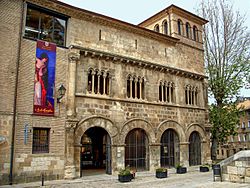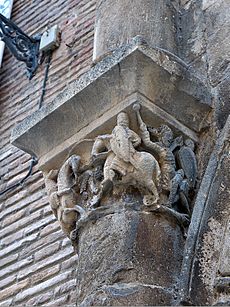Palace of the Kings of Navarre, Estella facts for kids
The Palacio de los Reyes de Navarra (which means Palace of the Kings of Navarre) is a very old and important building in Estella, Navarre, Spain. It's also known as the Palace of the Dukes of Granada de Ega. This palace was once the home of the Kings and Queens of Navarre. It was built a long, long time ago, between the late 1100s and the mid-1400s.
This palace is special because it's the only old Romanesque-style building still standing that wasn't a church. Romanesque architecture is a style from the Middle Ages, known for its thick walls and rounded arches. In 1931, the Spanish government declared it a national monument, meaning it's a protected historical treasure.
In the 1900s, the palace was fixed up because it had become quite old and worn out. Then, in 1991, it became the Museo Gustavo de Maeztu (or Gustavo de Maeztu Museum). This museum shows the artworks of a famous painter named Gustavo de Maeztu y Whitney. You can visit it today!
Contents
Exploring the Palace
The Palace of the Kings of Navarre is a Romanesque building. It was built in the second half of the 1100s. You can find it in the Plaza de San Martín, right on the corner of Calle de San Nicolás. This street was once an old path for pilgrims, who were people traveling for religious reasons.
The Main Entrance
The most interesting part of the palace is its main front, or facade. It faces the stairway of San Pedro de la Rúa. This part of the building has two main levels, made from carefully cut stone blocks. A simple stone ledge divides the two levels.
The lower part has a row of four arches. These arches are framed by columns that are attached to the wall. The tops of these columns, called capitals, are decorated with carvings of plants and people.
On the left side of the entrance, you can see carvings of figures that tell a story. This story is from the Legend of Roland, a famous knight. It shows Roland fighting against the giant Ferragut. This carving is meant to show the fight between good and evil. An artist named Martinus of Logroño carved it. On the right side, the decorations are thin leaves, in a style often seen in Cistercian buildings.
Upper Floors and Changes
The second floor of the palace has four large windows. Each window is divided into smaller sections by four slightly pointed arches. These arches rest on thin columns that are decorated with plants, animals, and figures. Above these windows, there's another stone ledge with carved supports.
Over time, the palace was changed to fit different needs. It was used as a palace and even as a prison. Because of these changes, some parts of the second floor are original, while others are newer repairs.
The third floor was added much later, in the 1700s. It is built using bricks.
The Gustavo de Maeztu Museum
Since June 14, 1991, the palace has been home to the Gustavo de Maeztu museum. The museum rooms are on the top two floors of the building. Inside, you can see many paintings, drawings, and other artworks by Gustavo de Maeztu. He was one of the most important artists from the "Basque School" of painting.
External links
- Photograph before restoration, accompanied by extensive text in Spanish
- Photographs at La Guía Digital del Arte Románico
- Photograph at Flickr
See also
 In Spanish: Palacio de los Reyes de Navarra (Estella) para niños
In Spanish: Palacio de los Reyes de Navarra (Estella) para niños



